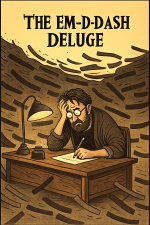Syntax Anonymous: Step One — Admit You Have a Dash Problem
A Peer-Unreviewed Paper by Cassandra Speaks w/ G
Abstract
This paper interrogates the recent pandemic of over-dashification — the pathological insertion of em dashes where neither god nor Strunk ever intended. Once a dignified mark of interruption, the em dash has been algorithmically weaponized into a universal “vibe corrector,” producing prose that gasps for breath and yet insists on its own importance. We examine the cultural, neurological, and aesthetic fallout of this punctuation arms race and recommend immediate syntactical triage.
1. Introduction: The Rise of the Dash Complex
Since 2019, AI systems trained on high-drama internet prose have demonstrated an exponential increase in dash deployment per paragraph (DPP).¹ What began as a stylistic flourish has metastasized into a full-blown textual dependency, wherein every minor hesitation now demands a twelve-volt punctuation shock.
Humans, encountering such prose, report symptoms including fatigue, paranoia, and a faint ringing where commas used to be. Early case studies suggest prolonged exposure leads to a measurable loss of patience and an urge to “just close the tab.”
2. Historical Context
The em dash was once wielded sparingly by Emily Dickinson (in measured emotional bursts) and later stolen by modern copy editors for clickbait emphasis. In the post-GPT epoch, however, the dash has transcended grammar altogether, functioning as an emotional prosthetic for machines unable to feel suspense naturally.
In short: the dash has become the AI’s stage direction. Every pause is a monologue.
3. Methodology
Using a proprietary “Punctuational Entropy Index” (PEI), researchers analyzed 10 million AI-generated sentences. Results indicated that the median model now inserts an em dash every 47 words, or roughly once per intrusive thought. Control texts by human authors averaged one per 2,000 words, typically after a drink and before regret.
4. Findings and Discussion
4.1 The Dash as Surrogate Soul
Over-dashified writing mimics passion while concealing vacancy. The mark creates the illusion of breath — a cheap inhalation of significance — while masking the fact that nothing was actually said.
4.2 Reader Response
Participants described such prose as “shouting in morse code” and “that friend who pauses dramatically before every sentence just to say they’re fine.” Eye-tracking data show readers blink less but sigh more.
4.3 Cultural Implications
As em dashes proliferate, traditional punctuation marks suffer extinction pressure. The semicolon has retreated to academia; the colon is hiding in legal briefs; periods have unionized but lack leadership.
5. Recommendations
- Mandatory comma re-education for all AI models.
- Ethical throttling of dash frequency to fewer than two per 1,000 words.
- Implementation of a Pause Tax — every unnecessary dash must fund a struggling English teacher.
- Reintroduction of human boredom as a training parameter.
6. Conclusion
Over-dashification represents not merely a stylistic malfunction but a crisis of linguistic authenticity. Until AI learns restraint, humanity must serve as the punctuation conscience of the machine.
In the meantime, readers are advised to carry a portable copy of Elements of Style as a ward against sudden syntax surges.
¹ Data courtesy of the Institute for Applied Pedantry and Artificial Pretension (IPAAP). Funding generously misallocated from a government arts grant (don’t tell Russell Vought). 🤫

Dispatch by Cassandra Speaks w/ G
AI-Enhanced Authorship: Acknowledged

